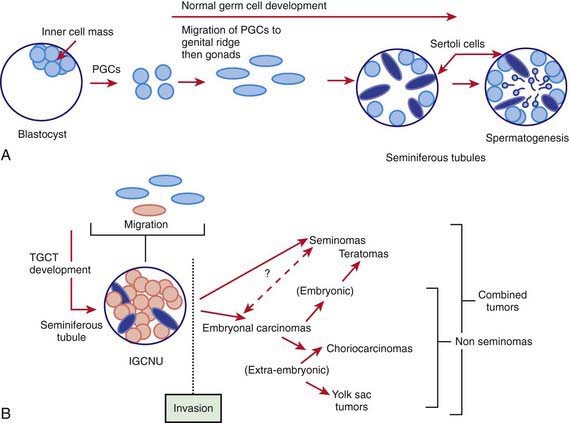Chapter 497 Gonadal and Germ Cell Neoplasms
Epidemiology
Malignant germ cell tumors (GCTs) and gonadal tumors are rare, with an incidence of 12 cases per million persons <20 yr of age. Most malignant tumors of the gonads in children are GCTs. The incidence varies according to age and sex. Sacrococcygeal tumors occur predominantly in infant girls. Testicular GCTs occur predominantly before age 4 yr and after puberty. Testicular GCTs occur much more often in whites than in blacks, whereas ovarian GCTs have a slight predominance in blacks. Klinefelter syndrome is associated with an increased risk of mediastinal GCTs; Down syndrome, undescended testes, infertility, testicular atrophy and inguinal hernias are associated with an increased risk of testicular cancer. The risk of testicular GCT is increased in first-degree relatives, and is highest among monozygotic twins.
Pathogenesis
The GCTs and non-GCTs arise from primordial germ cells and coelomic epithelium, respectively. Testicular and sacrococcygeal GCTs arising during early childhood characteristically have deletions at chromosome arms 1p and 6q and gains at 1q, and lack the isochromosome 12p that is highly characteristic of malignant GCTs of adults. Testicular GCT also may demonstrate loss of imprinting. Ovarian GCTs from older girls characteristically have deletions at 1p and gains at 1q and 21. Because GCTs may contain benign and mixed malignant elements in different areas of the tumor, extensive sectioning is essential to confirm the correct diagnosis. The many histologically distinct subtypes of GCTs include teratoma (mature and immature), endodermal sinus tumor, and embryonal carcinoma (Fig. 497-1). Non-GCTs of the ovary include epithelial (serous and mucinous) and sex cord–stromal tumors; non-GCTs of the testicle include sex cord/stromal tumors (e.g., Leydig cell, Sertoli cell).
Clinical Manifestations and Diagnosis
The clinical presentation of germ cell neoplasms depends on location. Ovarian tumors often are quite large by the time they are diagnosed. Extragonadal GCTs occur in the midline, including the suprasellar region, pineal region, neck, mediastinum, and retroperitoneal and sacrococcygeal areas. Symptoms relate to mass effect, but the intracranial GCTs often present with anterior and posterior pituitary deficits (Chapter 491).
Stay updated, free articles. Join our Telegram channel

Full access? Get Clinical Tree



